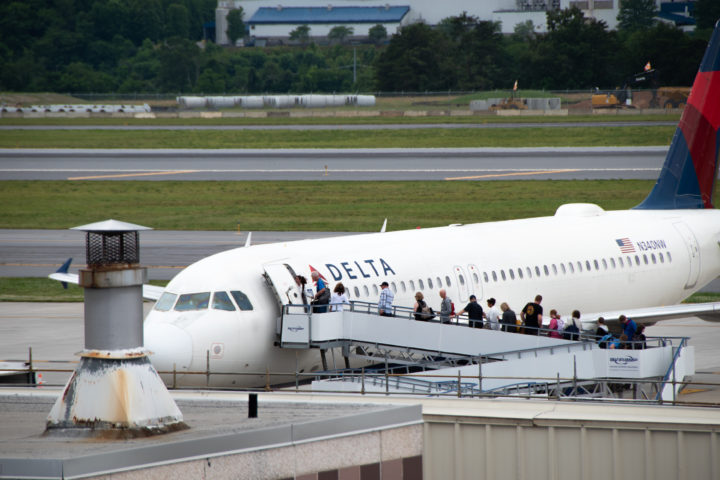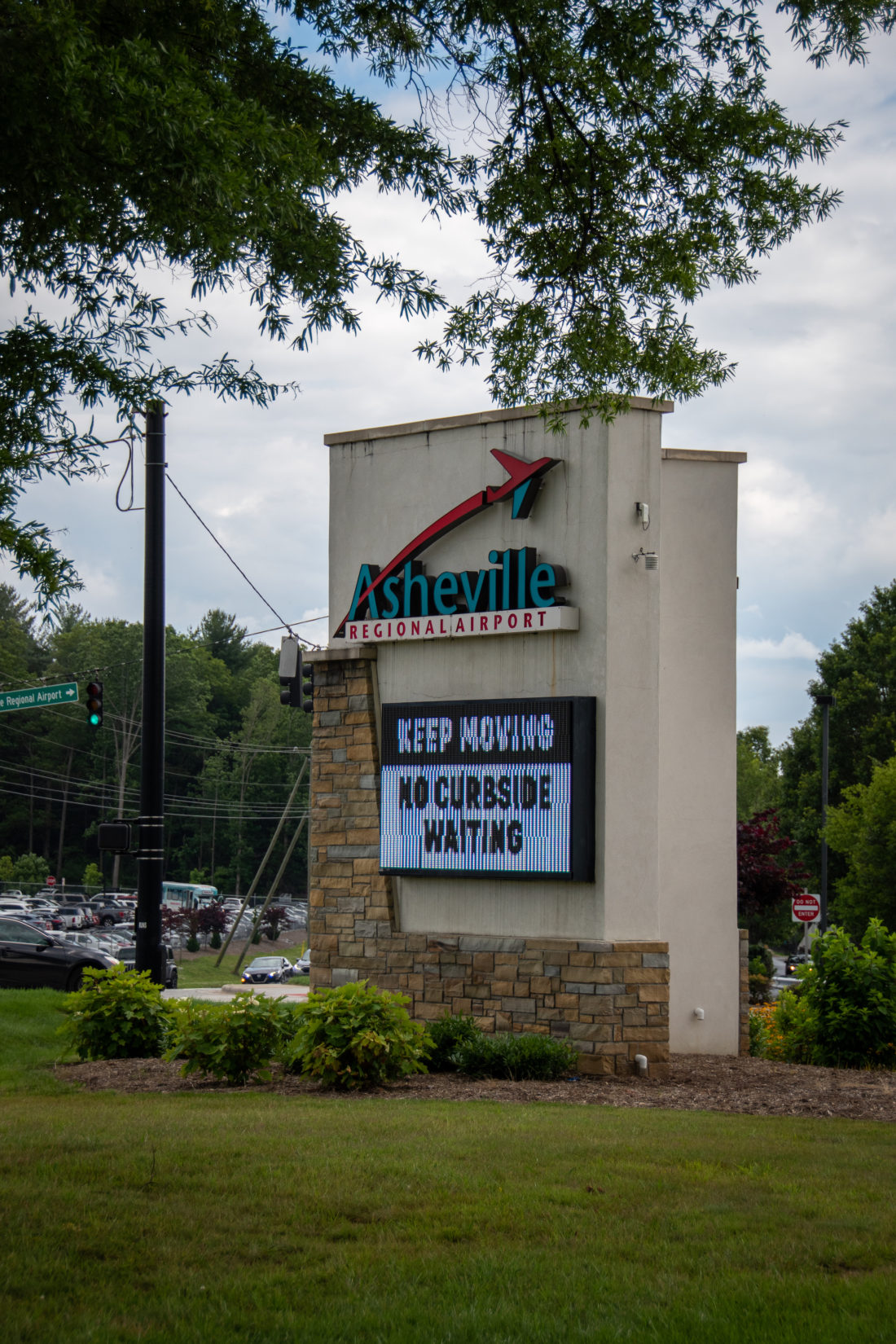The number of passengers served by Asheville Regional Airport is taking off faster than the commercial jets in which they ride. However, more travelers are creating parking headaches at the state’s third-busiest airport. At the same time, the airport earned the unfortunate distinction as having the third-worst rating for summer travel, according to Forbes Advisor.
“There is a national awareness of this market among the airline industry, which is terrific,” Tina Kinsey, the Greater Asheville Regional Airport Authority’s director of marketing, public relations and air service development, told members of the Buncombe County Tourism Development Authority at an April 26 meeting. “The airlines that are here are pleased with their utilization and profitability in our market. And that’s what it’s about for them. The planes are very full.”
In 2022, 922,000 passengers took off from Asheville’s airport, which sits on the Buncombe-Henderson county line. That’s 29% more than in 2021, and 15% more than the previous record year, 2019. As of April, the number of passengers — or enplanements as the airline industry calls the number of passengers that depart from an airport — is up another 25% in 2023 over last year’s record numbers.
The growth has outpaced all projections, already almost doubling numbers outlined in the airport’s 20-year master plan, drafted in 2013, for 2025 enplanements. In a 2018 study conducted by consultants CHA Design/Construction Solutions, the airport was projected to handle about 569,000 enplanements in 2023, just 62% of last year’s customer load.
“There is literally no way to predict this kind of growth — [Asheville Regional] was the fastest growing airport in the country [in 2019],” Kinsey says.
In 2022, the airport surpassed Piedmont Triad International Airport near Greensboro as the state’s third-busiest, and there’s no sign of the trend slowing. The two busiest are Charlotte Douglas International Airport and Raleigh-Durham International Airport.
“We have some significant momentum occurring in our market. Asheville and WNC is a place that people want to visit, and it’s also a place filled with people who love to travel by air. The airlines see this, and they continue to be profitable in our market, so they continue to grow,” Kinsey says.

With the addition of service to Phoenix in May, passengers now can fly to 26 destinations, 11 more than five years ago.
On-time turbulence
Atop the unprecedented growth, Asheville suffers flight delays beyond its control.
The height of airport congestion typically occurs in what are traditionally its two busiest months, July and October. In 2022, the airport saw an average of more than 6,200 passengers daily in both July and October.
That may help explain a recent Forbes Advisor report that ranked Asheville Regional as the third-worst airport for summer travel, based on 10 metrics affecting the punctuality of flights and airfare prices in June, July and August.
Asheville has the fourth-highest percentage of weather delays, sixth-highest percentage of delays caused by late-arriving aircraft and eighth-lowest percentage of on-time flights among the nation’s 100 busiest airports, according to the report.
In response to questions about delays, Alexandra Ingle, the airport’s brand and experience designer, says airport management can’t control the weather, delays originating elsewhere or Federal Aviation Administration-related holdups.
“The runway is not congested. Delayed arrivals are caused by other issues, mainly out of the control of the airport,” she says.
In fact, the Forbes report says Asheville’s ranking as the 15th-highest percentage of national aviation system delays is caused in part by heavy traffic volume as well as airport operations and air traffic control.
One issue that does sometimes slow arrivals is Asheville’s status as a one-runway airport. That means if a plane has a mechanical issue on the runway, the FAA holds arriving flights in the air until the runway is clear and safe for arrivals. But it’s a rare occurrence, Ingle says.
Kinsey says geographic realities mean Asheville will always be a one-runway airport, but it’s big enough to handle projected traffic for decades to come, partially because larger commercial jets typically used by the country’s largest airlines are now serving Asheville, meaning it takes fewer planes to serve the same number of passengers.

That trend of using larger jets is occurring industrywide as an ongoing pilot shortage parallels increasing passenger rates, says Tim Anderson, chair of the aviation management and career pilot technology program at A-B Tech.
The pilot shortage has been an issue since 2013 because of more certification requirements and an aging pilot population, he says.
The 2013 rule required commercial pilots to have 1,500 hours of total flight time, up from 250 hours. A-B Tech is the only school in the Carolinas that offers Airline Transport Pilot certification with only 1,250 hours, thanks to a federal exception, Anderson says.
Additionally, Congress is considering lifting the mandatory pilot retirement age from 65 to 67, which may alleviate the shortage in the short term, he says.
Parking pains
To help handle some of the traffic, the airport began construction on a new air traffic control tower in January, relocated to the west side of the runway for greater visibility and efficiency. It will break ground on a terminal expansion in August, adding five gates for a grand total of 12 when completed in late 2026.
All that construction can make flying out of AVL seem more chaotic than in years past, something airport leadership acknowledges.
“We know that we are experiencing growing pains. The fast-paced and significant growth year after year is very real, and we know that our passengers feel it. We hope that the excellent connectivity we all have now at Asheville is a big win for everyone. But we also have empathy regarding challenges that impact passengers — especially parking,” says Lew Bleiweis, president and CEO of the Greater Asheville Regional Airport Authority.
Parking is the complaint most heard by airport officials, and some ask why the airport doesn’t build a second parking garage to accommodate the influx of passengers, Bleiweis says.
A second garage is in the longer-term master plan, according to Kinsey, but for now, the airport is spreading out rather than up for additional spaces.
“We had already planned for an increase this summer by adding two additional overflow lots earlier this year, and we stood up a third temporary overflow lot very quickly in early June to help alleviate the continued surge in demand,” Kinsey says.
An additional 600-space shuttle lot under construction near the WNC Agricultural Center will open this fall, she says. That lot will bring the total available public spaces up to 3,200 in the garage, daily, shuttle and overflow lots.

For comparison, roughly 3,000 people on average flew from Asheville per day in July 2022, the busiest month to date.
During particularly high-usage times, the airport’s cellphone lot — where drivers typically wait for a passenger whose arrival has been delayed — opens for overflow parking, one of several temporary solutions that Kinsey acknowledges isn’t ideal.
“It takes significant time — often years — to go through the environmental, engineering, design, planning, bidding and building required to add more permanent parking to an airport. Additionally, we must be able to finance the cost. Airports are complex organizations with many regulations to follow, and the wheels do not turn quickly — even when growth is occurring faster than forecasted.”
In the meantime, Kinsey suggests travelers consider getting dropped off and picked up at the airport. If that’s not feasible, she says, passengers should arrive at least two hours before a flight to ensure there’s time to find parking, and if the main lots are full, attendants at the toll plaza will direct drivers to an overflow lot with shuttle service.
If you opt for a taxi or ride app, Kinsey says the designated pickup location will temporarily change “very soon” to the parking garage, allowing those waiting to do so out of the weather.
And to help pay for more spaces, parking fees have gone up starting this month. Daily parking now costs $12 a day and $72 a week, up from $10 and $60, respectively, and rates are higher in the garage and hourly lots. Kinsey says these rates are comparable to other airports in the Southeast.
Pardon its dust
While officials insist the runway size is sufficient, the terminal is not, and its forthcoming expansion may give passengers the feeling that they are flying out of a construction zone, especially during WNC’s peak travel months.
“Passengers will feel crowded during the peak hours of our peak months,” Kinsey acknowledged. “But this is a natural consequence of the higher-than-average growth our region is experiencing, and we are moving forward with our plan to alleviate this congestion.”
Currently, three gates are open in a modular building on the south end of the current terminal, which will allow the airport to maintain seven gates throughout construction. A new north concourse with seven gates and a larger waiting area is projected to be completed by the end of 2025, at which point the south end will be closed, demolished and rebuilt.
Ultimately, the airport will be 150% larger than it is now, designed to serve up to 4 million passengers a year with room for further future expansion, Kinsey says. Last year’s 1.8 million passengers had the airport bursting at the seams.
Until then, airport officials are asking for patience from passengers fighting for parking spaces and seats in concourse waiting areas while the airport grows.
“To be an organization that experiences double-digit growth year after year is challenging in many ways, and I am proud of the forward-thinking board and management team who have put the wheels in motion for all the great improvements that have recently taken place, and that are on the way,” Bleiweis says. “We’re working hard to continually improve your experience as we build for the future [Asheville airport]. It’s going to be worth it, I promise.”




Asheville airport reliabilty stats have deteriorated due to a much higher % of the flights being operated by carriers like Allegiant (10th of the 10 major US airlines) than was the case 5+ years ago. Allegiant has miserable operating performance.
Delta Air Lines (including regional partners) – 82.1% of flights on time
Alaska Airlines (including regional partners) – 79.1% of flights on time
United Airlines (including regional partners) – 78.7% of flights on time
American Airlines (including regional partners) – 77.1% of flights on time
Hawaiian Airlines – 75.8% of flights on time
Southwest Airlines – 73.2% of flights on time
Spirit Airlines – 73.0% of flights on time
Frontier Airlines – 66.1% of flights on time
JetBlue Airways – 64.6% of flights on time
Allegiant Air – 63.4% of flights on time
As ever, Aville persists in pandering to the low end. No reputable companies are interested in a place with an unstable foundation (infrastructure).
Will Asheville Airport ever have international flights?